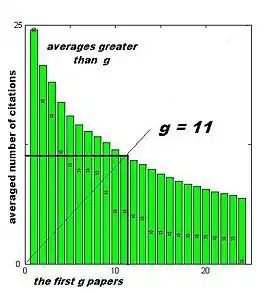g-index
The g-index is an author-level metric suggested in 2006 by Leo Egghe.[1] The index is calculated based on the distribution of citations received by a given researcher's publications, such that given a set of articles ranked in decreasing order of the number of citations that they received, the g-index is the unique largest number such that the top g articles received together at least g2 citations.
It can be equivalently defined as the largest number n of highly cited articles for which the average number of citations is at least n. This is in fact a rewriting of the definition

as
The g-index is an alternative for the older h-index, which does not average the numbers of citations. The h-index only requires a minimum of n citations for the least-cited article in the set and thus ignores the citation count of very highly cited papers. Roughly, the effect is that h is the number of papers of a quality threshold that rises as h rises; g allows citations from higher-cited papers to be used to bolster lower-cited papers in meeting this threshold. Therefore, in all cases g is at least h, and is in most cases higher.[1] However, unlike the h-index, the g-index saturates whenever the average number of citations for all published papers exceeds the total number of published papers; the way it is defined, the g-index is not adapted to this situation.
The g-index has been characterized in terms of three natural axioms by Woeginger (2008).[2] The simplest of these three axioms states that by moving citations from weaker articles to stronger articles, one's research index should not decrease. Like the h-index, the g-index is a natural number and thus lacks in discriminatory power. Therefore, Tol (2008) proposed a rational generalisation.[3]
Tol also proposed a collective g-index.
- Given a set of researchers ranked in decreasing order of their g-index, the g1-index is the (unique) largest number such that the top g1 researchers have on average at least a g-index of g1.
References
- Egghe, Leo (2006). "Theory and practise of the g-index". Scientometrics. 69 (1): 131–152. doi:10.1007/s11192-006-0144-7. hdl:1942/981.
- Woeginger, Gerhard J. (2008). "An axiomatic analysis of Egghe's g-index". Journal of Informetrics. 2 (4): 364–368. doi:10.1016/j.joi.2008.05.002.
- Tol, Richard S.J. (2008). "A rational, successive g-index applied to economics departments in Ireland". Journal of Informetrics. 2 (2): 149–155. doi:10.1016/j.joi.2008.01.001. preprint
